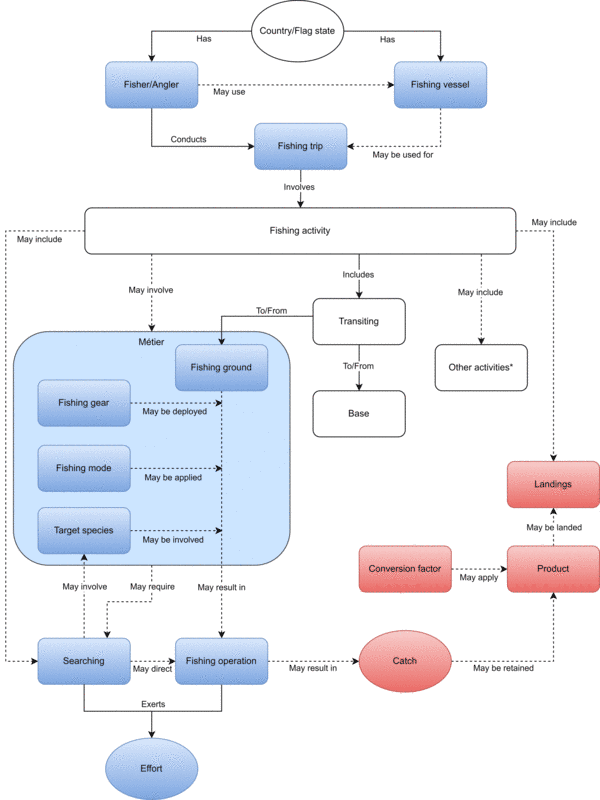Capture fishery statistics
The term capture fishery is used to describe a fishery conducted in an aquatic environment (e.g. marine, brackish or freshwater) and involving one or more fishery sectors (e.g. artisanal, industrial, subsistence, sport or recreational). Some fisheries require the use of fishing vessels while other fisheries may be conducted from the shoreline (e.g. shore-based). Catches may consist of wild-caught fish (herein taken to mean finfish) and other aquatic organisms, These catches may be landed for commercial purposes, or traded amongst communities or at markets, or utilized solely by fishers and their families, or some combination of each. In addition in some fisheries, a component of the catch may be utilized in aquaculture, such as the collection of wild-caught fish and other aquatic organisms for subsequent rearing in cages. Fisheries may be managed by local communities, national fisheries organizations or Regional Fishery Bodies (RFBs) such as a Regional Fisheries Management Organization (RFMO). The diversity of capture fisheries reflects each fishery’s purpose and adaptation to regional environmental, economic and cultural factors.
CWP develops and promotes common standards for capture fishery statistics for use by RFBs and other intergovernmental organizations involved with the collection and dissemination of fishery statistics. These include statistical concepts for catch and landings and fishing effort. A diagrammatic presentation of these concepts and their relationships in a generalized capture fishery is illustrated here and the reader may wish to refer to the sections on catch and landings and fishing effort where these concepts are described.
In the diagrammatic presentation of a generalized capture fishery, a fisher (or angler) conducts a fishing trip with the intention to catch fish or other aquatic organisms. Each fishing trip involves a sequence of fishing activities during which the fisher may practice one or more métier, each characterized by the type of fishing gear used, the target (or intended) species or species groups, the fishing ground used as well as the fishing mode where applicable. A métier is an overarching statistical concept which may also involve searching for aquatic organisms and/or conducting one or many fishing operations which, if successful, result in catch. Note that the statistical concept of métier corresponds to the fishing activity domain defined by FLUX (refer data exchange formats). Other fishing related activities conducted during a fishing trip may include inter alia transiting to/from a base, resting, sheltering, transhipments and transmitting/receiving fishery-related notifications. The catch may be retained whole or converted to fishery products and landed for commercial consumption, industrial use, or for the purposes of subsistence. A component of the catch may also be lost, depredated or discarded (alive or dead) during fishing. For statistical purposes, the nationality of the catch and landings is usually determined by the nationality of the fisher or the Flag state of the fishing vessel (if used), noting that this general arrangement may be modified to reflect established practices in specific cases.
Capture fisheries are an economic sector of society and coherent and consistent fishery statistics are required for effective policy-making, sectoral planning and the management and sustainable development of a fishery.
Purpose
Capture fishery statistics generally fall into three categories: (1) statistics documenting the removal of aquatic organisms, (2) statistics documenting the fishing effort and the fishing vessels/fleets (if used) that harvest the resources and (3) statistics documenting the labor force, income, costs and invested capital in each fishery sector.
Capture fishery statistics are essential as a basis for describing the contribution of fisheries to the national food supply and economy (e.g. through the system of national economic accounts) and the total removal of fish and other aquatic organisms from their environment. Policy-making often is done with one or more of the following objectives:
-
Manage capture fisheries within sustainable limits and in general accordance with the FAO Code of Conduct for Responsible Fisheries
-
Maintain or develop fishery production for domestic and export markets
-
Improve the socio-economic conditions of fishers.
The relationships between capture fishery statistics and essential policy objectives are key factors in analyzing the needs for fishery information. Fishery statistics may also inform monitoring, surveillance and control of capture fisheries.
The focus in best practice fishery management is the conservation and sustainability of natural resources using a precautionary ecosystem approach, ensuring food supply security and sustained economic performance through the control of fishing capacity, fishing effort (e.g. temporal/spatial access to resources) and the equitable allocation of catch limits and/or quotas. Refer also to the section on Fisheries statistics for an ecosystem approach.
CWP has developed a global standard to facilitate the reporting and exchange of statistical data on capture fisheries and aquaculture for use by CWP parties and national, regional and international organizations. This standard, known as the CWP Standard for Reference Harmonization, establishes the framework for a modular set of data structures for use in data collection and reporting among CWP parties at different levels of the data value chain. The standard consists of data structures and harmonized statistical concepts and four data structures are currently available for use in capture fisheries: (1) Global capture production, (2) Catch, (3) Catch and effort and (4) Logbook. The implementation of this standard and details on the data structures are available under the CWP information sharing practices.
Resources for capture fishery statistics
FAO. 1995. Code of Conduct for Responsible Fisheries. Rome, FAO. 41 pp. (also available at http://www.fao.org/3/v9878e/V9878E.pdf).
FAO. 2022. Report of the twenty-seventh session of the Coordinating Working Party on Fishery Statistics. Rome, Italy, 20-24 June 2022. FAO Fisheries and Aquaculture Report No. 1397. Rome, FAO. 51 pp. (also available at https://www.fao.org/3/cc3232en/cc3232en.pdf).
FAO. Concepts and definitions - Fisheries and Resources Monitoring System (FIRMS). [Cited 15 September 2024]. http://firms.fao.org/firms/concepts/en

Diagrammatic presentation of statistical concepts and relationships in a generalized capture fishery. Concepts that exert fishing effort are shaded blue (refer fishing effort for detail) and simplified catch concepts are shaded red (refer catch and landings for detail). Dashed lines represent optional relationships. *Other activities include inter alia fisher resting, vessel at anchor/sheltering, transhipments and transmitting/receiving fishery-related notifications.

